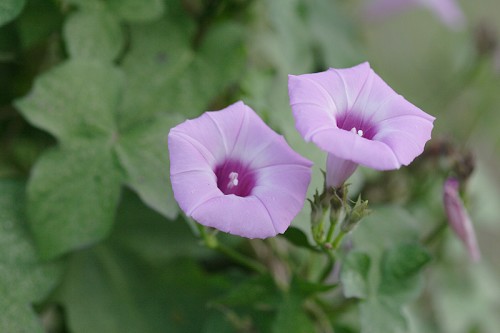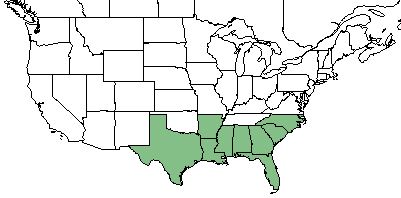Difference between revisions of "Ipomoea cordatotriloba"
(→Taxonomic Notes) |
HaleighJoM (talk | contribs) (→Ecology) |
||
| (9 intermediate revisions by 5 users not shown) | |||
| Line 19: | Line 19: | ||
}} | }} | ||
==Taxonomic Notes== | ==Taxonomic Notes== | ||
| − | Synonyms: ''I. trifida'' | + | Synonyms: ''Ipomoea trichocarpa'' Elliott; ''I. trifida''.<ref name="weakley">Weakley, A.S. 2015. Flora of the southern and mid-atlantic states. Working Draft of 21 May 2015. University of North Carolina at Chapel Hill, Chapel Hill, North Carolina.</ref> |
| − | Varieties: | + | Varieties: ''Ipomoea cordatotriloba'' Dennstedt ''var. cordatotriloba''.<ref name="weakley">Weakley, A.S. 2015. Flora of the southern and mid-atlantic states. Working Draft of 21 May 2015. University of North Carolina at Chapel Hill, Chapel Hill, North Carolina.</ref> |
==Description== | ==Description== | ||
| Line 28: | Line 28: | ||
==Distribution== | ==Distribution== | ||
| − | + | Its range extends from southeast North Carolina to southern Florida, then west to east Texas and Arizona.<ref name="weakley">Weakley, A.S. 2015. Flora of the southern and mid-atlantic states. Working Draft of 21 May 2015. University of North Carolina at Chapel Hill, Chapel Hill, North Carolina.</ref> | |
==Ecology== | ==Ecology== | ||
===Habitat=== <!--Natural communities, human disturbed habitats, topography, hydrology, soils, light, fire regime requirements for removal of competition, etc.--> | ===Habitat=== <!--Natural communities, human disturbed habitats, topography, hydrology, soils, light, fire regime requirements for removal of competition, etc.--> | ||
| − | ''I. cordatotriloba'' is found in dunes, sandy areas on barrier islands, and other sandy habitats. <ref name= "Weakley 2015"> Weakley, A. S. (2015). Flora of the Southern and Mid-Atlantic States. Chapel Hill, NC, University of North Carolina Herbarium. </ref> | + | ''I. cordatotriloba'' is found in dunes, sandy areas on barrier islands, and other sandy habitats. <ref name= "Weakley 2015"> Weakley, A. S. (2015). Flora of the Southern and Mid-Atlantic States. Chapel Hill, NC, University of North Carolina Herbarium. </ref> Specimens have been collected from sand of roadside depression, sand floodplain, and margin of thin woods. <ref name = "FSU herbarium"> URL: http://herbarium.bio.fsu.edu. Last accessed: June 2018. Collectors: R. Komarek, R.k. Godfrey, Andre Clewell, Pat Ferral, John Nelson, Loran C. Anderson, J.M. Kane. States and counties: Florida (Leon, Liberty, Jefferson, Franklin) Georgia (Thomas) South Carolina (Georgetown)</ref> |
===Phenology=== <!--Timing off flowering, fruiting, seed dispersal, and environmental triggers. Cite PanFlora website if appropriate: http://www.gilnelson.com/PanFlora/ --> | ===Phenology=== <!--Timing off flowering, fruiting, seed dispersal, and environmental triggers. Cite PanFlora website if appropriate: http://www.gilnelson.com/PanFlora/ --> | ||
| − | ''I. cordatotriloba'' | + | ''I. cordatotriloba'' has been observed to flower in June, July, and September. <ref name= "PanFlora"> Nelson, G. PanFlora: Plant data for the eastern United States with emphasis on the Southeastern Coastal Plains, Florida, and the Florida Panhandle. www.gilnelson.com/PanFlora/ Accessed: 22 MAY 2018 </ref> |
<!--===Seed dispersal===--> | <!--===Seed dispersal===--> | ||
<!--===Seed bank and germination===--> | <!--===Seed bank and germination===--> | ||
| − | |||
| − | |||
| − | |||
| − | |||
| − | ==Conservation and | + | ===Fire ecology=== |
| + | It has been observed flowering in recently burned wetland. <ref name ="FFE">Observation by Edwin Bridges in Big Cypress National Preserve, Collier COunty, Septmber 30, 2009, posted to Florida Flora and Ecosystematics Facebook Group January 2017. </ref> | ||
| + | <!--Fire tolerance, fire dependence, adaptive fire responses--> | ||
| + | ===Pollination=== | ||
| + | Butterflies are commonly found in proximity to ''I. cordatotriloba'', skippers in particular. <ref name ="FFE">Observation by Roger Hammer Rodney Felix post, Santa Rosa County, 25 SPR, April 28, 2017, posted to Florida Flora and Ecosystematics Facebook Group. </ref> | ||
| + | <!--===Herbivory and toxicology===--> | ||
| + | <!--===Diseases and parasites===--> | ||
| + | |||
| + | ==Conservation, cultivation, and restoration== | ||
''I. cordatotriloba'' is listed as a noxious weed by the Arizona Department of Agriculture Plant Services Division and the Arkansas State Plant Board. <ref name= "USDA Plant Database"/> | ''I. cordatotriloba'' is listed as a noxious weed by the Arizona Department of Agriculture Plant Services Division and the Arkansas State Plant Board. <ref name= "USDA Plant Database"/> | ||
| − | == | + | ==Cultural use== |
==Photo Gallery== | ==Photo Gallery== | ||
<gallery widths=180px> | <gallery widths=180px> | ||
</gallery> | </gallery> | ||
==References and notes== | ==References and notes== | ||
Latest revision as of 16:28, 13 July 2022
Common name: tievine [1], coastal morning-glory [2]
| Ipomoea cordatotriloba | |
|---|---|

| |
| Photo by the Southeastern Flora Database | |
| Scientific classification | |
| Kingdom: | Plantae |
| Division: | Magnoliophyta - Flowering plants |
| Class: | Magnoliopsida - Dicots |
| Order: | Solanales |
| Family: | Convolvulaceae |
| Genus: | Ipomoea |
| Species: | I. cordatotriloba |
| Binomial name | |
| Ipomoea cordatotriloba Dennst. | |

| |
| Natural range of Ipomoea cordatotriloba from USDA NRCS Plants Database. | |
Contents
[hide]Taxonomic Notes
Synonyms: Ipomoea trichocarpa Elliott; I. trifida.[3]
Varieties: Ipomoea cordatotriloba Dennstedt var. cordatotriloba.[3]
Description
I. cordatotriloba is a perennial forb/herb/vine of the Convolvulaceae family native to North America. [1]
Distribution
Its range extends from southeast North Carolina to southern Florida, then west to east Texas and Arizona.[3]
Ecology
Habitat
I. cordatotriloba is found in dunes, sandy areas on barrier islands, and other sandy habitats. [2] Specimens have been collected from sand of roadside depression, sand floodplain, and margin of thin woods. [4]
Phenology
I. cordatotriloba has been observed to flower in June, July, and September. [5]
Fire ecology
It has been observed flowering in recently burned wetland. [6]
Pollination
Butterflies are commonly found in proximity to I. cordatotriloba, skippers in particular. [6]
Conservation, cultivation, and restoration
I. cordatotriloba is listed as a noxious weed by the Arizona Department of Agriculture Plant Services Division and the Arkansas State Plant Board. [1]
Cultural use
Photo Gallery
References and notes
- ↑ Jump up to: 1.0 1.1 1.2 USDA Plant Database https://plants.usda.gov/core/profile?symbol=IPCOC2
- ↑ Jump up to: 2.0 2.1 Weakley, A. S. (2015). Flora of the Southern and Mid-Atlantic States. Chapel Hill, NC, University of North Carolina Herbarium.
- ↑ Jump up to: 3.0 3.1 3.2 Weakley, A.S. 2015. Flora of the southern and mid-atlantic states. Working Draft of 21 May 2015. University of North Carolina at Chapel Hill, Chapel Hill, North Carolina.
- Jump up ↑ URL: http://herbarium.bio.fsu.edu. Last accessed: June 2018. Collectors: R. Komarek, R.k. Godfrey, Andre Clewell, Pat Ferral, John Nelson, Loran C. Anderson, J.M. Kane. States and counties: Florida (Leon, Liberty, Jefferson, Franklin) Georgia (Thomas) South Carolina (Georgetown)
- Jump up ↑ Nelson, G. PanFlora: Plant data for the eastern United States with emphasis on the Southeastern Coastal Plains, Florida, and the Florida Panhandle. www.gilnelson.com/PanFlora/ Accessed: 22 MAY 2018
- ↑ Jump up to: 6.0 6.1 Observation by Edwin Bridges in Big Cypress National Preserve, Collier COunty, Septmber 30, 2009, posted to Florida Flora and Ecosystematics Facebook Group January 2017. Cite error: Invalid
<ref>tag; name "FFE" defined multiple times with different content